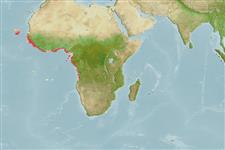Teleostei (teleosts) >
Beloniformes (Needle fishes) >
Exocoetidae (Flyingfishes)
Etymology: Prognichthys: Taken from Progne, name of Philomela´s sister, transformed into a swallow in the Greek mithology + Greek, ichthys = fish (Ref. 45335).
Eponymy: Not a true eponym, Progne (sometimes Procne – see above) was metamorphosed into a swallow. Pliny likened flyingfish to the swallow, and the genus name can be translated as ‘swallow-fish’. (Ref. 128868), visit book page.
More on author: Valenciennes.
Environment: milieu / climate zone / depth range / distribution range
Ecology
Marine; pelagic-neritic; oceanodromous (Ref. 51243); depth range 0 - ? m. Tropical
Eastern Atlantic: Parin (1999, Ref. 47968) has shown that Prognichthys gibbifrons, previously considered to be widely distributed Atlantic species is actually restricted to waters adjacent to the western coast of tropical Africa.
Size / Weight / Age
Maturity: Lm ? range ? - ? cm
Max length : 19.5 cm SL male/unsexed; (Ref. 4498)
Occurs in surface waters and capable of leaping out of the water and gliding for long distances above the surface (Ref. 3613).
Life cycle and mating behavior
Maturity | Reproduction | Spawning | Eggs | Fecundity | Larvae
Parin, N.V. and R.H. Gibbs Jr., 1990. Exocoetidae. p. 583-591. In J.C. Quero, J.C. Hureau, C. Karrer, A. Post and L. Saldanha (eds.) Check-list of the fishes of the eastern tropical Atlantic (CLOFETA). JNICT, Lisbon; SEI, Paris; and UNESCO, Paris. Vol. 2. (Ref. 4498)
IUCN Red List Status (Ref. 130435: Version 2024-2)
Threat to humans
Harmless
Human uses
Fisheries: minor commercial
Tools
Special reports
Download XML
Internet sources
Estimates based on models
Preferred temperature (Ref.
123201): 16.2 - 25.8, mean 19.7 °C (based on 69 cells).
Phylogenetic diversity index (Ref.
82804): PD
50 = 0.5156 [Uniqueness, from 0.5 = low to 2.0 = high].
Bayesian length-weight: a=0.00631 (0.00288 - 0.01384), b=3.05 (2.85 - 3.25), in cm total length, based on LWR estimates for this (Sub)family-body shape (Ref.
93245).
Trophic level (Ref.
69278): 3.4 ±0.4 se; based on size and trophs of closest relatives
Resilience (Ref.
120179): High, minimum population doubling time less than 15 months (Preliminary K or Fecundity.).
Fishing Vulnerability (Ref.
59153): Low vulnerability (14 of 100).
